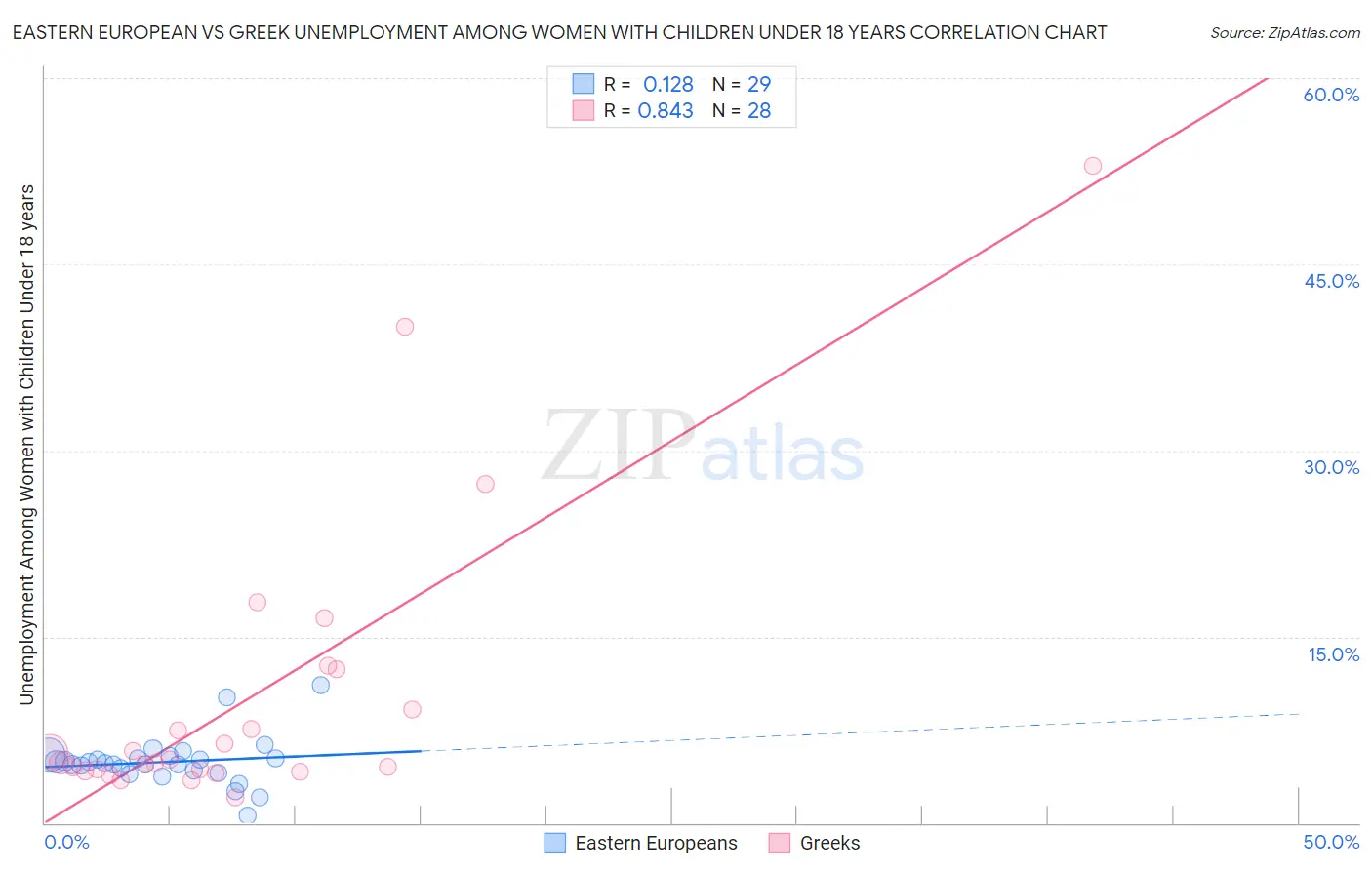Eastern European vs Greek Unemployment Among Women with Children Under 18 years
COMPARE
Eastern European
Greek
Unemployment Among Women with Children Under 18 years
Unemployment Among Women with Children Under 18 years Comparison
Eastern Europeans
Greeks
5.0%
UNEMPLOYMENT AMONG WOMEN WITH CHILDREN UNDER 18 YEARS
98.9/ 100
METRIC RATING
42nd/ 347
METRIC RANK
5.0%
UNEMPLOYMENT AMONG WOMEN WITH CHILDREN UNDER 18 YEARS
99.0/ 100
METRIC RATING
40th/ 347
METRIC RANK
Eastern European vs Greek Unemployment Among Women with Children Under 18 years Correlation Chart
The statistical analysis conducted on geographies consisting of 432,926,663 people shows a poor positive correlation between the proportion of Eastern Europeans and unemployment rate among women with children under the age of 18 in the United States with a correlation coefficient (R) of 0.128 and weighted average of 5.0%. Similarly, the statistical analysis conducted on geographies consisting of 453,324,679 people shows a very strong positive correlation between the proportion of Greeks and unemployment rate among women with children under the age of 18 in the United States with a correlation coefficient (R) of 0.843 and weighted average of 5.0%, a difference of 0.14%.

Unemployment Among Women with Children Under 18 years Correlation Summary
| Measurement | Eastern European | Greek |
| Minimum | 0.60% | 2.0% |
| Maximum | 11.1% | 52.9% |
| Range | 10.5% | 50.9% |
| Mean | 4.9% | 10.1% |
| Median | 4.8% | 5.0% |
| Interquartile 25% (IQ1) | 4.1% | 4.3% |
| Interquartile 75% (IQ3) | 5.3% | 10.7% |
| Interquartile Range (IQR) | 1.2% | 6.5% |
| Standard Deviation (Sample) | 2.0% | 11.8% |
| Standard Deviation (Population) | 1.9% | 11.6% |
Demographics Similar to Eastern Europeans and Greeks by Unemployment Among Women with Children Under 18 years
In terms of unemployment among women with children under 18 years, the demographic groups most similar to Eastern Europeans are Turkish (5.0%, a difference of 0.050%), Immigrants from Bosnia and Herzegovina (5.0%, a difference of 0.080%), Immigrants from Moldova (5.0%, a difference of 0.11%), Immigrants from Malaysia (5.0%, a difference of 0.20%), and Immigrants from Korea (5.0%, a difference of 0.31%). Similarly, the demographic groups most similar to Greeks are Immigrants from Bosnia and Herzegovina (5.0%, a difference of 0.060%), Turkish (5.0%, a difference of 0.19%), English (5.0%, a difference of 0.25%), Immigrants from Moldova (5.0%, a difference of 0.26%), and Immigrants from Malaysia (5.0%, a difference of 0.34%).
| Demographics | Rating | Rank | Unemployment Among Women with Children Under 18 years |
| Cypriots | 99.3 /100 | #31 | Exceptional 5.0% |
| Dutch | 99.3 /100 | #32 | Exceptional 5.0% |
| Croatians | 99.3 /100 | #33 | Exceptional 5.0% |
| Immigrants | South Central Asia | 99.2 /100 | #34 | Exceptional 5.0% |
| Luxembourgers | 99.2 /100 | #35 | Exceptional 5.0% |
| Mongolians | 99.2 /100 | #36 | Exceptional 5.0% |
| Poles | 99.2 /100 | #37 | Exceptional 5.0% |
| Bhutanese | 99.2 /100 | #38 | Exceptional 5.0% |
| English | 99.1 /100 | #39 | Exceptional 5.0% |
| Greeks | 99.0 /100 | #40 | Exceptional 5.0% |
| Immigrants | Bosnia and Herzegovina | 99.0 /100 | #41 | Exceptional 5.0% |
| Eastern Europeans | 98.9 /100 | #42 | Exceptional 5.0% |
| Turks | 98.9 /100 | #43 | Exceptional 5.0% |
| Immigrants | Moldova | 98.9 /100 | #44 | Exceptional 5.0% |
| Immigrants | Malaysia | 98.8 /100 | #45 | Exceptional 5.0% |
| Immigrants | Korea | 98.7 /100 | #46 | Exceptional 5.0% |
| British | 98.7 /100 | #47 | Exceptional 5.0% |
| Northern Europeans | 98.6 /100 | #48 | Exceptional 5.0% |
| Lithuanians | 98.4 /100 | #49 | Exceptional 5.0% |
| Immigrants | Japan | 98.4 /100 | #50 | Exceptional 5.0% |
| Yugoslavians | 98.3 /100 | #51 | Exceptional 5.1% |